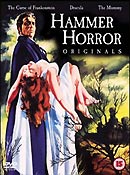
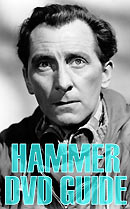 |
DRACULA
[aka HORROR OF DRACULA]
Director: Terence
Fisher
Starring:
Peter Cushing, Christopher Lee, John Van Eyssen, Michael Gough
The original Ė
and best Ė of the Dracula films that Hammer Studios made during the
fifties, sixties and seventies, 1958ís Dracula is only loosely
based on Stokerís famous novel, although that still makes it one of the
most faithful adaptations committed to celluloid.
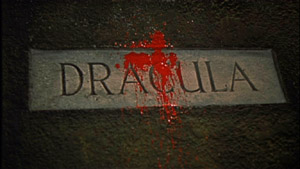 Like
all Hammer films, Dracula was created by a team of craftsmen, many
of who spent their entire working life at the studio. Hammer had dabbled a
little with science fiction and horror themes before Dracula (most
notably with the filmís immediate predecessor, The Curse of
Frankenstein), but to look at the film youíd think that theyíd
been specialising in gothic romance for decades. The film is imbued with
rich olde world ambience, thanks to the outstanding work of production
designer Bernard Robinson. Peter Cushing and Christopher Lee would become
genre icons, of course, but you can also see the seeds of Hammerís stock
repertory company of accomplished character actors, like Charles Lloyd
Pack and George Woodbridge, who also appear here. The film also features
two actors who would rarely appear for Hammer, but who would nevertheless
gain a solid reputation among fans of the genre:
Geoffrey
Bayldon
and Michael Gough. Like
all Hammer films, Dracula was created by a team of craftsmen, many
of who spent their entire working life at the studio. Hammer had dabbled a
little with science fiction and horror themes before Dracula (most
notably with the filmís immediate predecessor, The Curse of
Frankenstein), but to look at the film youíd think that theyíd
been specialising in gothic romance for decades. The film is imbued with
rich olde world ambience, thanks to the outstanding work of production
designer Bernard Robinson. Peter Cushing and Christopher Lee would become
genre icons, of course, but you can also see the seeds of Hammerís stock
repertory company of accomplished character actors, like Charles Lloyd
Pack and George Woodbridge, who also appear here. The film also features
two actors who would rarely appear for Hammer, but who would nevertheless
gain a solid reputation among fans of the genre:
Geoffrey
Bayldon
and Michael Gough.
Director Terence Fisher manages to keep
the film flowing smoothly with some surprisingly sophisticated camera
set-ups and flourishes, all beautifully captured by Jack Asherís
mournful Technicolor cinematography. Although they made dozens of similar
films over the next couple of decades, Hammer never really recaptured the
ethereal look of Dracula, (despite recycling many of the filmís
set elements, props and costumes!)
 No
previous home video version of Dracula has been entirely
satisfactory. The most recent UK VHS versions presented the filmís
opening titles in letterbox format, but the rest of the film full-frame.
(Like the DVD, the VHS versions carried the filmís Horror of Dracula title).
The American NTSC laserdisc was better, but still dull and lifeless. The
DVD transfer is remarkably good, especially considering the problems that
Technicolor source materials often present. The DVD is presented in a
widescreen ratio of 1.78:1, shaving a few percent from the top of the
image, but adding considerable picture information to the sides, compared
to the VHS and US laserdisc versions. The compositions are sometimes a
little tight at the top of the frame, but generally the presentation is
substantially improved. No
previous home video version of Dracula has been entirely
satisfactory. The most recent UK VHS versions presented the filmís
opening titles in letterbox format, but the rest of the film full-frame.
(Like the DVD, the VHS versions carried the filmís Horror of Dracula title).
The American NTSC laserdisc was better, but still dull and lifeless. The
DVD transfer is remarkably good, especially considering the problems that
Technicolor source materials often present. The DVD is presented in a
widescreen ratio of 1.78:1, shaving a few percent from the top of the
image, but adding considerable picture information to the sides, compared
to the VHS and US laserdisc versions. The compositions are sometimes a
little tight at the top of the frame, but generally the presentation is
substantially improved.
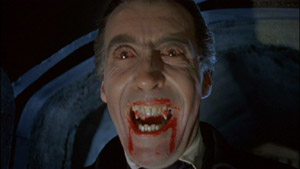 The
higher resolution offered by DVD also helps greatly, picking out nuances
and details that were simply fuzzy blurs on earlier copies. The greatest
improvements have been made to the filmís colour. The VHS and laserdisc
copies both favoured a drab autumnal colour balance. The new transfer
takes the best qualities of the earlier versions, but adds much more blue
to the mix (Jonathan Harkerís jacket is almost grey on the VHS version,
whereas on the DVD itís a starling peacock blue). This boost adds
considerably to the filmís atmosphere Ė in many shots thereís a hazy
blue mist hanging in the air, which is practically invisible on the VHS
versions. There are improvements, too, to the flesh-tones, and even
surprising splashes of vibrant colour (the stained glass windows in
Harkerís room, and the flags draped along the wall beside Draculaís
staircase, for example). The new disc faithfully reproduces the best
theatrical prints that have been shown in public over the last decade or
so (the BFIís Century of Cinema version, and the fine BBC print shown at
the Barbicanís Hammer season, for example). The
higher resolution offered by DVD also helps greatly, picking out nuances
and details that were simply fuzzy blurs on earlier copies. The greatest
improvements have been made to the filmís colour. The VHS and laserdisc
copies both favoured a drab autumnal colour balance. The new transfer
takes the best qualities of the earlier versions, but adds much more blue
to the mix (Jonathan Harkerís jacket is almost grey on the VHS version,
whereas on the DVD itís a starling peacock blue). This boost adds
considerably to the filmís atmosphere Ė in many shots thereís a hazy
blue mist hanging in the air, which is practically invisible on the VHS
versions. There are improvements, too, to the flesh-tones, and even
surprising splashes of vibrant colour (the stained glass windows in
Harkerís room, and the flags draped along the wall beside Draculaís
staircase, for example). The new disc faithfully reproduces the best
theatrical prints that have been shown in public over the last decade or
so (the BFIís Century of Cinema version, and the fine BBC print shown at
the Barbicanís Hammer season, for example).
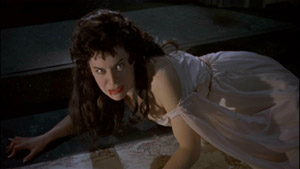 If
youíre familiar with the existing home video versions, youíll be
amazed at the lack of print artefacts. The print isnít pristine, but the
constant shower of dirt that is present throughout lengthy passages of the
VHS version (the scene where Harker wakes up after being attacked by the
Count, for example) has been almost entirely eliminated on the disc. Also
missing are a couple of familiar moments of obvious print damage. The film
appears to be uncut (certainly the shot of blood welling up as Van
Helsingís stake penetrates one of his victims, missing from some
versions of the film, is present here, as it has been for the most recent
couple of UK VHS releases). If
youíre familiar with the existing home video versions, youíll be
amazed at the lack of print artefacts. The print isnít pristine, but the
constant shower of dirt that is present throughout lengthy passages of the
VHS version (the scene where Harker wakes up after being attacked by the
Count, for example) has been almost entirely eliminated on the disc. Also
missing are a couple of familiar moments of obvious print damage. The film
appears to be uncut (certainly the shot of blood welling up as Van
Helsingís stake penetrates one of his victims, missing from some
versions of the film, is present here, as it has been for the most recent
couple of UK VHS releases).
The mono audio (at 192kbps) is adequate,
allowing James Bernardís monumental score room to permeate. There is
some minor distortion, but no more than might reasonably be expected from
a film of this era and provenance.
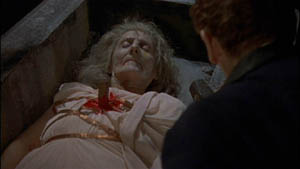 Warner
Home Video has performed a minor miracle in restoring this film to
something approaching perfection, for which we should be very grateful
indeed, but the disc only has a battered theatrical trailer to support it,
which borders on the criminal for a film of this importance. Even a simple
presentation of the filmís original Dracula British title
sequence would have been appreciated. There is no doubt that a licensee
like Anchor Bay or Blue Underground would have moved heaven and earth to
include a commentary track from the usually accommodating Christopher Lee,
or some of the other surviving participants. Warner
Home Video has performed a minor miracle in restoring this film to
something approaching perfection, for which we should be very grateful
indeed, but the disc only has a battered theatrical trailer to support it,
which borders on the criminal for a film of this importance. Even a simple
presentation of the filmís original Dracula British title
sequence would have been appreciated. There is no doubt that a licensee
like Anchor Bay or Blue Underground would have moved heaven and earth to
include a commentary track from the usually accommodating Christopher Lee,
or some of the other surviving participants.
The film is available in the UK as part
of the Hammer Horror Originals box set that also contains The
Curse of Frankenstein and The Mummy, but can be purchased
individually in the US. Itís unlikely, though, that the NTSC disc will
capture the precise colour balance of the movie as well as the PAL
transfer does.
|




 Like
all Hammer films, Dracula was created by a team of craftsmen, many
of who spent their entire working life at the studio. Hammer had dabbled a
little with science fiction and horror themes before Dracula (most
notably with the filmís immediate predecessor, The Curse of
Frankenstein), but to look at the film youíd think that theyíd
been specialising in gothic romance for decades. The film is imbued with
rich olde world ambience, thanks to the outstanding work of production
designer Bernard Robinson. Peter Cushing and Christopher Lee would become
genre icons, of course, but you can also see the seeds of Hammerís stock
repertory company of accomplished character actors, like Charles Lloyd
Pack and George Woodbridge, who also appear here. The film also features
two actors who would rarely appear for Hammer, but who would nevertheless
gain a solid reputation among fans of the genre:
Like
all Hammer films, Dracula was created by a team of craftsmen, many
of who spent their entire working life at the studio. Hammer had dabbled a
little with science fiction and horror themes before Dracula (most
notably with the filmís immediate predecessor, The Curse of
Frankenstein), but to look at the film youíd think that theyíd
been specialising in gothic romance for decades. The film is imbued with
rich olde world ambience, thanks to the outstanding work of production
designer Bernard Robinson. Peter Cushing and Christopher Lee would become
genre icons, of course, but you can also see the seeds of Hammerís stock
repertory company of accomplished character actors, like Charles Lloyd
Pack and George Woodbridge, who also appear here. The film also features
two actors who would rarely appear for Hammer, but who would nevertheless
gain a solid reputation among fans of the genre:
 No
previous home video version of Dracula has been entirely
satisfactory. The most recent UK VHS versions presented the filmís
opening titles in letterbox format, but the rest of the film full-frame.
(Like the DVD, the VHS versions carried the filmís Horror of Dracula title).
The American NTSC laserdisc was better, but still dull and lifeless. The
DVD transfer is remarkably good, especially considering the problems that
Technicolor source materials often present. The DVD is presented in a
widescreen ratio of 1.78:1, shaving a few percent from the top of the
image, but adding considerable picture information to the sides, compared
to the VHS and US laserdisc versions. The compositions are sometimes a
little tight at the top of the frame, but generally the presentation is
substantially improved.
No
previous home video version of Dracula has been entirely
satisfactory. The most recent UK VHS versions presented the filmís
opening titles in letterbox format, but the rest of the film full-frame.
(Like the DVD, the VHS versions carried the filmís Horror of Dracula title).
The American NTSC laserdisc was better, but still dull and lifeless. The
DVD transfer is remarkably good, especially considering the problems that
Technicolor source materials often present. The DVD is presented in a
widescreen ratio of 1.78:1, shaving a few percent from the top of the
image, but adding considerable picture information to the sides, compared
to the VHS and US laserdisc versions. The compositions are sometimes a
little tight at the top of the frame, but generally the presentation is
substantially improved.  The
higher resolution offered by DVD also helps greatly, picking out nuances
and details that were simply fuzzy blurs on earlier copies. The greatest
improvements have been made to the filmís colour. The VHS and laserdisc
copies both favoured a drab autumnal colour balance. The new transfer
takes the best qualities of the earlier versions, but adds much more blue
to the mix (Jonathan Harkerís jacket is almost grey on the VHS version,
whereas on the DVD itís a starling peacock blue). This boost adds
considerably to the filmís atmosphere Ė in many shots thereís a hazy
blue mist hanging in the air, which is practically invisible on the VHS
versions. There are improvements, too, to the flesh-tones, and even
surprising splashes of vibrant colour (the stained glass windows in
Harkerís room, and the flags draped along the wall beside Draculaís
staircase, for example). The new disc faithfully reproduces the best
theatrical prints that have been shown in public over the last decade or
so (the BFIís Century of Cinema version, and the fine BBC print shown at
the Barbicanís Hammer season, for example).
The
higher resolution offered by DVD also helps greatly, picking out nuances
and details that were simply fuzzy blurs on earlier copies. The greatest
improvements have been made to the filmís colour. The VHS and laserdisc
copies both favoured a drab autumnal colour balance. The new transfer
takes the best qualities of the earlier versions, but adds much more blue
to the mix (Jonathan Harkerís jacket is almost grey on the VHS version,
whereas on the DVD itís a starling peacock blue). This boost adds
considerably to the filmís atmosphere Ė in many shots thereís a hazy
blue mist hanging in the air, which is practically invisible on the VHS
versions. There are improvements, too, to the flesh-tones, and even
surprising splashes of vibrant colour (the stained glass windows in
Harkerís room, and the flags draped along the wall beside Draculaís
staircase, for example). The new disc faithfully reproduces the best
theatrical prints that have been shown in public over the last decade or
so (the BFIís Century of Cinema version, and the fine BBC print shown at
the Barbicanís Hammer season, for example). If
youíre familiar with the existing home video versions, youíll be
amazed at the lack of print artefacts. The print isnít pristine, but the
constant shower of dirt that is present throughout lengthy passages of the
VHS version (the scene where Harker wakes up after being attacked by the
Count, for example) has been almost entirely eliminated on the disc. Also
missing are a couple of familiar moments of obvious print damage. The film
appears to be uncut (certainly the shot of blood welling up as Van
Helsingís stake penetrates one of his victims, missing from some
versions of the film, is present here, as it has been for the most recent
couple of UK VHS releases).
If
youíre familiar with the existing home video versions, youíll be
amazed at the lack of print artefacts. The print isnít pristine, but the
constant shower of dirt that is present throughout lengthy passages of the
VHS version (the scene where Harker wakes up after being attacked by the
Count, for example) has been almost entirely eliminated on the disc. Also
missing are a couple of familiar moments of obvious print damage. The film
appears to be uncut (certainly the shot of blood welling up as Van
Helsingís stake penetrates one of his victims, missing from some
versions of the film, is present here, as it has been for the most recent
couple of UK VHS releases). Warner
Home Video has performed a minor miracle in restoring this film to
something approaching perfection, for which we should be very grateful
indeed, but the disc only has a battered theatrical trailer to support it,
which borders on the criminal for a film of this importance. Even a simple
presentation of the filmís original Dracula British title
sequence would have been appreciated. There is no doubt that a licensee
like Anchor Bay or Blue Underground would have moved heaven and earth to
include a commentary track from the usually accommodating Christopher Lee,
or some of the other surviving participants.
Warner
Home Video has performed a minor miracle in restoring this film to
something approaching perfection, for which we should be very grateful
indeed, but the disc only has a battered theatrical trailer to support it,
which borders on the criminal for a film of this importance. Even a simple
presentation of the filmís original Dracula British title
sequence would have been appreciated. There is no doubt that a licensee
like Anchor Bay or Blue Underground would have moved heaven and earth to
include a commentary track from the usually accommodating Christopher Lee,
or some of the other surviving participants.